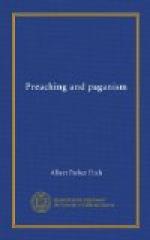CHAPTER SEVEN
WORSHIP AS THE CHIEF APPROACH TO TRANSCENDENCE
Whatever becomes the inward and the invisible grace of the Christian community such will be its outward and visible form. Those regulative ideas and characteristic emotions which determine in any age the quality of its religious experience will be certain to shape the nature and conduct of its ecclesiastical assemblies. Their influence will show, both in the liturgical and homiletical portions of public worship. If anything further were needed, therefore, to indicate the secularity of this age, its substitutes for worship and its characteristic type of preaching would, in themselves, reveal the situation. So we venture to devote these closing discussions to some observations on the present state of Protestant public worship and the prevailing type of Protestant preaching. For we may thus ascertain how far those ideas and perceptions which an age like ours needs are beginning to find an expression and what means may be taken to increase their influence through church services in the community.
We begin, then, in this chapter, not with preaching, but with worship. It seems to me clear that the chief office of the church is liturgical rather than homiletical. Or, if that is too technical a statement, it may be said that the church exists to set forth and foster the religious life and that, because of the nature of that life, it finds its chief opportunity for so doing in the imaginative rather than the rationalizing or practical areas of human expression. Even as Michael Angelo, at the risk of his life, purloined dead bodies that he might dissect them and learn anatomy, so all disciples of the art of religion need the discipline of intellectual analysis and of knowledge of the facts of the religious experience if they are to be leaders in faith. There is a toughness of fiber needed in religious people that can only come through such mental discipline. But anatomists are not sculptors. Michael Angelo was the genius, the creative artist, not because he understood anatomy, but chiefly because of those as yet indefinable and secret processes of feeling and intuition in man, which made him feel rather than understand the pity and the terror, the majesty and the pathos of the human spirit and reveal them in significant and expressive line. Knowledge supported rather than rivaled insight. In the same way, both saint and sinner need religious instruction. Nevertheless they are what they are because they are first perceptive rather than reasoning beings. They both owe, the one his salvation, the other his despair, to the fact that they have seen the vision of the holy universe. Both are seers; the saint has given his allegiance to the heavenly vision. The sinner has resolved to be disobedient unto it. Both find their first and more natural approach to religious truth, therefore, through the creative rather than the critical processes, the emotional rather than the informative powers.




